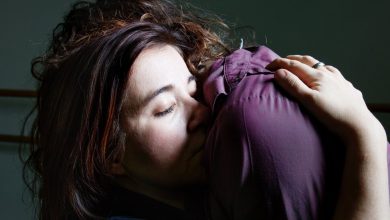A Detroit Designer Works From Home

This article is part of a series examining Responsible Fashion, and innovative efforts to address issues facing the fashion industry.
DETROIT — When Tracy Reese introduced her sustainable fashion brand, Hope for Flowers, in 2019, she knew she had to do things differently. Previously, for her now-shuttered namesake line, she would release no fewer than 10 collections in an average year — not including Plenty, her capsule collection, and other project developments. That meant a total of about 30 collections to produce each year.
These days, Hope for Flowers releases about five collections, 15 to 25 pieces each, that include her colorful dresses, tops, skirts and pants.
“It had to be just a completely different business model than the one we were functioning in before,” she said during an interview at her office in Detroit. “And it’s not that the old one was so bad, but we were over-designing, we were overdeveloping, we were overproducing.
Ms. Reese’s work space is housed in the city’s YouthVille Center, a facility that’s bustling with children participating in academic and cultural programs. Here, she has a team of five full-time employees, who handle everything from design to marketing to garment making, surrounded by colorful, mixed-print furniture, collage boards propped against the walls and clothing racks.
In 2018, after more than 30 years in New York City, Ms. Reese, 58, moved back to her hometown. She knew she wanted to create an environmentally conscious fashion line that would take a slower approach to garment making, asking herself the question: How do you make a desirable product that’s responsible, accessible and profitable?
“You either have the choice of kind of trying to compete with fast fashion, which is almost impossible,” Ms. Reese said, “or trying to offer something that fast fashion definitely cannot, that the customer recognizes as different than what she’s getting.”
The switch from her first label, which she introduced in 1996 — and which led to her dressing Tracee Ellis Ross, Sarah Jessica Parker and Michelle Obama, hosting runway shows at New York Fashion Week and appearing at retailers in the United States and Japan — didn’t come without its readjustments.
In the years leading up to spring 2018, when she released the last line from the original label, Ms. Reese noticed more and more how fast fashion was affecting the contemporary market — the middle lane of retail that attracts consumers who follow fashion but consume within relatively affordable price points.
Fast fashion, with its low cost appeal, captured the attention of the typical contemporary customer, who, among other reasons, recognize it as an opportunity to keep up with the latest trends and barely break the bank, despite its manufacturing and materials methods. Yet even with these changes in the industry and pressure from her two business partners to follow suit, Ms. Reese refused.
“We had a lot of retailers coming to us asking us to knock ourselves off at lower price points,” Ms. Reese said. “It kind of went against everything that I was learning to believe in and understand about the footprint of our industry.”
Even though her name was on the label, Ms. Reese owned just 30 percent of the shares, while her business partners owned 70, which was challenging at times because she didn’t have final say in much, particularly the financial decisions. This, along with how fast fashion “decimated the sector,” contributed to her exploring the transition to a new opportunity.
“I felt so free,” she said. “I couldn’t keep a smile off my face. And I don’t mean that in a malicious way. It was just a huge unburdening.”
Originally from Michigan, Ms. Reese also wanted to be closer to her family and saw advantages to being in her hometown of Detroit, which has gained more attention recently as a fashion hub. And although her production is handled in China for now, the goal, eventually, is to move it to the Midwest.
“It’s a less dog-eat-dog environment. New York is very cutthroat, and everybody’s keeping up with the Joneses,” she said. “There are so many talented people here who have had the opportunity for their work to be seen or to collaborate or to learn more about how to actually manufacture and distribute. That part is really super positive.”
To have a sustainable fashion brand, the focus isn’t solely on environmentally safe materials, although that is a major factor. Elizabeth Cline, the head of advocacy and policy for Remake, a nonprofit organization centered on climate and gender issues in the fashion industry, said that it’s common for organizations and brands to look at sustainability “in a silo” and focus on materials, but that’s not the whole picture.
Changes can be made in shipping methods that have a low carbon footprint; recyclable and safe packing materials can be explored; and employees can be paid fair wages.
Remake, which scores companies based on their environmental and social impact and logs the scores in a brand directory, has not rated Hope for Flowers yet, but Ms. Cline said small companies that produce higher quality products that don’t overproduce tend to score better in its assessment.
According to Ms. Cline, the Tracy Reese label is a good example of a slow fashion line. “It’s not focused on churning out as many styles as possible every season,” she said.
Ms. Reese, who was a fellow in the 2018-2019 CFDA + Lexus Fashion Initiative, now works primarily with organic cotton, linen and different types of wood-sourced cellulosic fiber from sustainably forested trees.
“Really changing to work more responsibly and only using earth-friendly materials, it was a huge adjustment for me as a designer because we’re going from just picking whatever is beautiful to a very short list of safe materials,” Ms. Reese said. “Then within that shortlist, to try and find the suppliers who are at least somewhat transparent about the source of their fibers.”
At the top of her list, according to Ms. Reese, are simple natural fibers like linen. She also uses organic cotton, which falls somewhere in the middle.
“There’s a lot of debate about cotton and organic cotton, but cotton is the No. 1 used fiber in the world,” she said. “I would rather use organic cotton and know that the people harvesting this crop are safer than the ones that are harvesting a crop that is treated with pesticides. So that’s a choice there.”
She is also working with recycled wool and nylon fibers for fall and winter as well as organic cotton with small amounts of spandex, a synthetic material typically added for stretch. It’s an imperfect choice she makes with some consideration.
“Finding responsible spandex is no joke,” she said. “I’m looking at percentages, and I have to weigh the usefulness of the garment. So I am saying, ‘OK,I’m going to agree to use this 4 percent spandex in this organic cotton blend because this garment is going to fit better. It’s going to fit more people than it would if it didn’t stretch.’”
In the past, for her previous label, it was normal to send sales and fit samples, color cards and swatches back and forth to factories in China and India for testing a couple times a week, which would cost $30,000 to $40,000 a month via FedEx. The arrival of Covid-19 was an added layer of pressure. During the worst of the pandemic, Ms. Reese had to figure out how to transfer work so it could be done digitally.
That meant using digital color matching systems to get the exact shade in the lab, which she had resisted for years. Ms. Reese had always collected swatches of yarn and fabric for inspiration. The digital color, she said, was just not as vibrant.
But there were advantages. It’s actually easier for the factory to work with digital color. Otherwise, she said, they take a physical fabric swatch and cut it up into pieces, “for themselves, a piece for the printer, a piece for the dyer.”
Making this shift, she said, resulted in less waste and a smaller carbon footprint. Now the average FedEx shipping cost for her sampling and production in China ebbs and flows, but it’s in the $1,500 to $3,000 range.
Ms. Reese’s goal is to move her production to Detroit, historically a manufacturing hub, though not for textiles. Some small-batch production is taking place at the offices but is still in its infancy. For instance, the company released its first batch of T-shirts using organic cotton mesh from Japan in April.
It was Shibori-dyed by one of Ms. Reese’s apprentices in a Japanese hand-dyeing technique that involves bunching fabric. Selling about 30 units for $150 each, she estimates that a shirt probably cost “three times” what she was able to sell it for.
To consumers, it isn’t always clear what goes into making a $250 pair of pants or a $400 dress or a $150 T-shirt, and many would consider $150 too expensive, but Ms. Reese explained that she’s also looking at the price of paying her team appropriately and all that goes into thoughtful production.
“The dyeing was definitely hand-craft, and there was trial and error,” she said. “Our fabric changed from sample to production. Even just coming up with the color formulas took a week. So we think about a week’s pay to come up with color formulas and then another couple of weeks to meticulously hand-dye all of these units.”
A global fast fashion market that’s currently valued at $99.23 billion has put pressure on many companies, especially smaller ones, to meet similar price points by working with harmful materials and factories that don’t pay a livable wage.
“They’re not competing on a level playing field,” Ms. Cline said. “The companies that cheat their workers pursue low price at all costs. They’re the ones that the market and the fashion industry are set up to reward.”
One of the things Ms. Reese finds most rewarding is collaborating with other artists and designers in the community to create opportunities on a micro-level. On most weekends, she teams up with art educators to teach children about art and design. Their June workshops centered on caring for and repairing beloved clothing items by replacing buttons and finding alternatives to dry cleaning to extend the life of garments.
In the fall, Ms. Reese hopes to relocate her office to a large space that’s currently under construction inside a green building in the historic Sugar Hill district of the city. There, she plans to expand her production and continue the workshops.
“It’s so important that we show different examples, especially to young people, of how to live more responsibly,” she said. “Because every bit of marketing, everything they see on social media, is telling them that they should consume and throw away and get some more.”




